 Justice League: Rebirth #1 — Writer/Penciler: Brian Hitch; Inks: Daniel Henriques with Scott Hanna; Colors: Alex Sinclair
Justice League: Rebirth #1 — Writer/Penciler: Brian Hitch; Inks: Daniel Henriques with Scott Hanna; Colors: Alex Sinclair
The Flintstones #1 — Writer: Mark Russell; Art: Steve Pugh; Colors: Chris Chuckry
Loads of second issues from DC this week, but only a few first ones: Justice League: Rebirth is basically “New Superman joins the Justice League while they’re fighting a super-big threat”; it does its job of introducing the current versions of all the heroes, and of course Hitch makes them look like a twelve-year-old comics fan’s dream, although you have to squint a little to ignore the thin plot (it’s worrying that Hitch will be writing, not illustrating, the ongoing series; having Hitch solely as 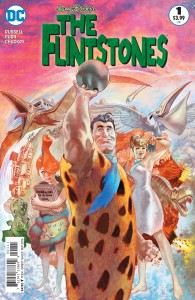 writer is like hiring Brian Michael Bendis just to draw your comic). This intro will bring readers back; will regular artists Tony Daniel and Jesus Merino keep them? Come back in a few months and let us know. The Flintstones, like its sister title Wacky Raceland, takes a beloved but low-selling cartoon property and updates it by getting rid of the slapstick and genial humor and replacing it with queasy adult jokes (a cocktail bar in Bedrock is called “Homo Erectus”) and odd choices (Mr. Slate is drawn like a live-action Phil Silvers, and Wilma, seeing his mansion, says “It’s like a Skymall magazine in here.” How does that line, on any level, make sense?). Strictly on its own terms, as a prehistoric pastiche, this is perversely interesting, but as a “Flintstones” comic it will disappoint readers hoping for some of the simple, direct charm of the original version.
writer is like hiring Brian Michael Bendis just to draw your comic). This intro will bring readers back; will regular artists Tony Daniel and Jesus Merino keep them? Come back in a few months and let us know. The Flintstones, like its sister title Wacky Raceland, takes a beloved but low-selling cartoon property and updates it by getting rid of the slapstick and genial humor and replacing it with queasy adult jokes (a cocktail bar in Bedrock is called “Homo Erectus”) and odd choices (Mr. Slate is drawn like a live-action Phil Silvers, and Wilma, seeing his mansion, says “It’s like a Skymall magazine in here.” How does that line, on any level, make sense?). Strictly on its own terms, as a prehistoric pastiche, this is perversely interesting, but as a “Flintstones” comic it will disappoint readers hoping for some of the simple, direct charm of the original version.
 Batman #2 — Writer: Tom King; Pencils: David Finch; Inks: Matt Banning and Danny Miki; Colors: Jordie Bellaire
Batman #2 — Writer: Tom King; Pencils: David Finch; Inks: Matt Banning and Danny Miki; Colors: Jordie Bellaire
Superman #2 — Writer: Peter J. Tomasi; Pencils: Patrick Gleason; Inks: Mick Gray; Colors: John Kalisz
Green Lanterns #2 — Writer: Sam Humphries; Pencils: Robson Rocha; Inks: Jay Leisten; Colors: Blond
Green Arrow #2 — Writer: Benjamin Percy; Art/Colors: Otto Schmidt
Aquaman #2 — Writer: Dan Abnett; Pencils: Scot Eaton; 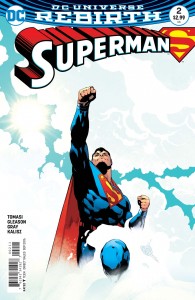 Inks: Wayne Faucher; Colors: Gabe Eltaeb
Inks: Wayne Faucher; Colors: Gabe Eltaeb
Future Quest #2 — Writer: Jeff Parker; Art: Evan “Doc” Shaner, Ron Randall and Jonathan Case; Colors: Jordie Ballaire
Of the second issues, the Big Two, Batman and Superman, do the best job of establishing their status quos and giving the audience a reason to keep reading: Batman by opening with a multi-page Solomon Grundy fight, to demonstrate what its hero can do, then percolating some sub-plots while showcasing members of the supporting cast like Alfred and Commissioner Gordon, and wrapping up with the intro of the next big villain, a canny choice who’s old-school, but hasn’t been used much lately; it all looks fun and exciting, 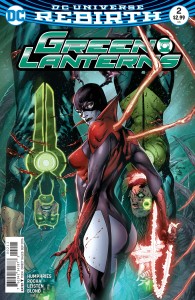 thanks to old-pro bat-artist David Finch’s fluid action and smooth people shots. Superman works by offering its older, married-to-Lois Man of Steel, recognizably Superman yet so different from the new-52 younger version, training his newly-powered son and establishing his father/husband/family relationships for new readers; it doesn’t actually advance the main plot much (the villain-intro at the end leaves us about where we were on the last page of the previous issue), but Gleason makes everyone look so shiny and inviting (with Kalisz’s coloring really making the father/son costumes pop) that we’re happy to spend time with these characters, and get to know their world. The other sophomore issues are a little less successful: Green Lanterns has its two rookie ring-bearers defending Earth against a massive Red Lantern plot, but
thanks to old-pro bat-artist David Finch’s fluid action and smooth people shots. Superman works by offering its older, married-to-Lois Man of Steel, recognizably Superman yet so different from the new-52 younger version, training his newly-powered son and establishing his father/husband/family relationships for new readers; it doesn’t actually advance the main plot much (the villain-intro at the end leaves us about where we were on the last page of the previous issue), but Gleason makes everyone look so shiny and inviting (with Kalisz’s coloring really making the father/son costumes pop) that we’re happy to spend time with these characters, and get to know their world. The other sophomore issues are a little less successful: Green Lanterns has its two rookie ring-bearers defending Earth against a massive Red Lantern plot, but 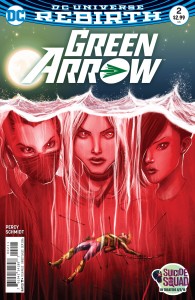 not that much actually happens; it’s obviously a second-issue chapter of a longer arc, with a lot of what’s-going-on and a dawning realization of the true threat, setting up the real action for the next few issues. It gets by on some character-building, and Rocha’s art makes everyone attractive (he has a facility with drawing people that reminds me of Gary Frank), but like Marvel’s new Black Panther, it’s more written-for-the-trade than effective as a single issue. Green Arrow has some of the same feel: it’s in one of those tear-down-the-hero stories (Ollie gets betrayed, shot full of arrows, loses his fortune, etc.), which will eventually, of course, build him back up — so by the end of this second issue he’s vowing to start fighting back,
not that much actually happens; it’s obviously a second-issue chapter of a longer arc, with a lot of what’s-going-on and a dawning realization of the true threat, setting up the real action for the next few issues. It gets by on some character-building, and Rocha’s art makes everyone attractive (he has a facility with drawing people that reminds me of Gary Frank), but like Marvel’s new Black Panther, it’s more written-for-the-trade than effective as a single issue. Green Arrow has some of the same feel: it’s in one of those tear-down-the-hero stories (Ollie gets betrayed, shot full of arrows, loses his fortune, etc.), which will eventually, of course, build him back up — so by the end of this second issue he’s vowing to start fighting back,  making this mostly a bridge to a meatier story next issue. Great as a chapter in a trade, again, but not so satisfying as a stand-alone story (although one thing in this book’s favor, at least for older fans, is the way they’re getting him back to old-school basics: Black Canary as a partner/sometime lover, Ollie with his familiar sculpted beard, etc.). Aquaman, on the surface (heh… it’s a comic that lends itself to puns, even inadvertent ones…) may be the most conservative of all the second issues; it’s a fight with standard nemesis Black Manta, following a pattern that it’s trod maybe a dozen times before. Abnett, however, is a better writer than that, and so at least ends the
making this mostly a bridge to a meatier story next issue. Great as a chapter in a trade, again, but not so satisfying as a stand-alone story (although one thing in this book’s favor, at least for older fans, is the way they’re getting him back to old-school basics: Black Canary as a partner/sometime lover, Ollie with his familiar sculpted beard, etc.). Aquaman, on the surface (heh… it’s a comic that lends itself to puns, even inadvertent ones…) may be the most conservative of all the second issues; it’s a fight with standard nemesis Black Manta, following a pattern that it’s trod maybe a dozen times before. Abnett, however, is a better writer than that, and so at least ends the 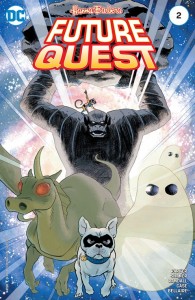 confrontation a bit differently; even so, a book about a character like Arthur needs to give readers lots of widescreen, wtf? moments to show why they should care about him, and this hasn’t delivered very many of those yet. Future Quest does exactly that; from its opening, with Space Ghost, the Herculoids and the Galaxy Trio fighting in deep space, to the Earth encounters with Jonny Quest, Birdman, and SG cohorts Jace, Jan and the monkey, to the bad guys revealed on the last page, it’s an energetic mashup of cartoon characters that should satisfy anyone who spent too many Saturday mornings glued to the TV set as a kid.
confrontation a bit differently; even so, a book about a character like Arthur needs to give readers lots of widescreen, wtf? moments to show why they should care about him, and this hasn’t delivered very many of those yet. Future Quest does exactly that; from its opening, with Space Ghost, the Herculoids and the Galaxy Trio fighting in deep space, to the Earth encounters with Jonny Quest, Birdman, and SG cohorts Jace, Jan and the monkey, to the bad guys revealed on the last page, it’s an energetic mashup of cartoon characters that should satisfy anyone who spent too many Saturday mornings glued to the TV set as a kid.
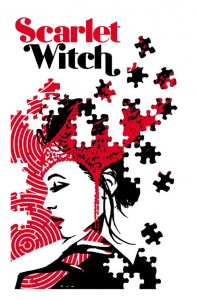 Scarlet Witch #8 — Writer: James Robinson; Art/Colors: Tula Lotay
Scarlet Witch #8 — Writer: James Robinson; Art/Colors: Tula Lotay
Amazing Spider-Man #15 — Writers: Dan Slott and Christos Gage; Pencils: Giuseppe Camuncoli; Inks: Cam Smith; Colors: Marte Gracia
Silver Surfer #5 — Writer: Dan Slott; Art: Michael Allred; Colors: Laura Allred
Punisher #3 — Writer: Becky Cloonan; Art: Steve Dillon; Colors: Frank Martin
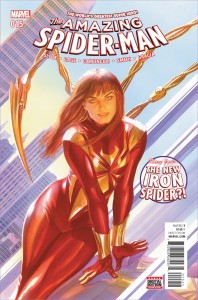 Doctor Strange: Prelude #1 (of 2) — Writer: Will Corona Pilgrim; Art: Jorge Fornes; Colors: Jesus Aburtov
Doctor Strange: Prelude #1 (of 2) — Writer: Will Corona Pilgrim; Art: Jorge Fornes; Colors: Jesus Aburtov
Scarlet Witch has to be the best-looking comic on the stands right now: behind the striking, uniformly excellent David Aja covers, each issue since #4 has had a different interior artist; the three before the current one were Javier Pulido, Marguerite Sauvage and Annie Wu, and with this week’s #8 we get the awesome Tula Lotay, whose ethereal coloring and excellent figure work made her work with Warren Ellis on Supreme: Blue Rose such a pleasure. Writer Robinson’s been doing a good job of making each 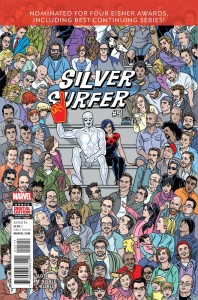 issue a self-contained story, while moving ahead the larger plot about magic being “broken” and Wanda traveling the world to fix it; this episode, about her talks with an analyst, involves little magical combat, but lots of clever plotting and psychological insight. If you’re not reading this book, you’re missing some good stories — and an ongoing parade of artistic talent. Amazing Spider-Man wraps up a three-parter about the power-siphoning bad guy Regent, who’s captured a bunch of heroes and absorbed their powers, leaving it to… well, the cover’s just over there to the above right, so you can see who has to save the day, and considering Spidey and Iron Man are both involved, it’s a
issue a self-contained story, while moving ahead the larger plot about magic being “broken” and Wanda traveling the world to fix it; this episode, about her talks with an analyst, involves little magical combat, but lots of clever plotting and psychological insight. If you’re not reading this book, you’re missing some good stories — and an ongoing parade of artistic talent. Amazing Spider-Man wraps up a three-parter about the power-siphoning bad guy Regent, who’s captured a bunch of heroes and absorbed their powers, leaving it to… well, the cover’s just over there to the above right, so you can see who has to save the day, and considering Spidey and Iron Man are both involved, it’s a 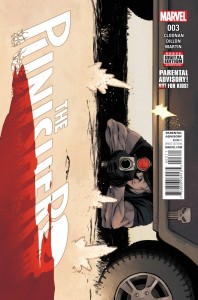 fun and logical development. As always, this title’s a decent blend of action, suspense and soap-opera style subplots, a dependable, straight-ahead Marvel comic. Silver Surfer is by Slott, too, but he takes advantage of his stellar artist, Allred, to make it considerably trippier and more cosmic than ASM — and to good effect; as the cover notes, the book’s been nominated for four Eisner awards this year. This issue begins a two-part story, and is a perfect chance for curious readers to sample the book’s charms. Punisher boasts good art, too — by Steve Dillon, whose clear, thin line and ability to draw unblinking, horrible violence committed by seemingly-ordinary people served
fun and logical development. As always, this title’s a decent blend of action, suspense and soap-opera style subplots, a dependable, straight-ahead Marvel comic. Silver Surfer is by Slott, too, but he takes advantage of his stellar artist, Allred, to make it considerably trippier and more cosmic than ASM — and to good effect; as the cover notes, the book’s been nominated for four Eisner awards this year. This issue begins a two-part story, and is a perfect chance for curious readers to sample the book’s charms. Punisher boasts good art, too — by Steve Dillon, whose clear, thin line and ability to draw unblinking, horrible violence committed by seemingly-ordinary people served 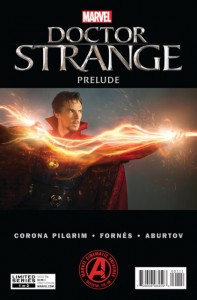 him well for years on this title, back when he and Garth Ennis were collaborating on it (and after they’d wrapped the similarly-brutal Preacher). Here, writer Becky Cloonan provides him plenty of opportunity to show his talents, and the result’s about as good as you’re going to get for a frank Castle comic. That leaves Doctor Strange, which bills itself as a prelude to the coming movie, and even has a still of Benedict Cumberbatch on the cover. It’s a bit of a bait and switch, though — no Doc inside; instead, we get an origin of sorts for Wong, and a couple of other mystic-arts players, so if you’re only interested in the main character you might want to spend your money on the excellent regular-series Doctor Strange back issues instead.
him well for years on this title, back when he and Garth Ennis were collaborating on it (and after they’d wrapped the similarly-brutal Preacher). Here, writer Becky Cloonan provides him plenty of opportunity to show his talents, and the result’s about as good as you’re going to get for a frank Castle comic. That leaves Doctor Strange, which bills itself as a prelude to the coming movie, and even has a still of Benedict Cumberbatch on the cover. It’s a bit of a bait and switch, though — no Doc inside; instead, we get an origin of sorts for Wong, and a couple of other mystic-arts players, so if you’re only interested in the main character you might want to spend your money on the excellent regular-series Doctor Strange back issues instead.
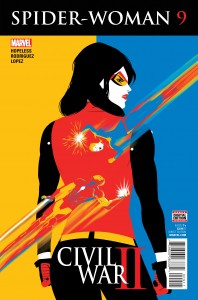 Spider-Woman #9 — Writer: Dennis Hopeless; Pencils/Colors: Javier Rodriguez; Inks: Alvaro Lopez
Spider-Woman #9 — Writer: Dennis Hopeless; Pencils/Colors: Javier Rodriguez; Inks: Alvaro Lopez
Invincible Iron Man #11 — Writer: Brian Michael Bendis; Art: Mike Deodato; Colors: Frank Martin
Totally Awesome Hulk #8 — Writer: Greg Pak; Pencils: Alan Davis; Inks: Mark Farmer; Colors: Chris Sotomayor
Kingpin #1 (of 4) — (Main Story) Writer: Matthew Rosenberg; Art: Ricardo Lopez Ortiz; Colors: Mat Lopes (Second Story) Writer: Matthew Rosenbertg; Pencils: Dalibor Talajic; Inks: Jose Marzan Jr.; Colors: Miroslav Mrva
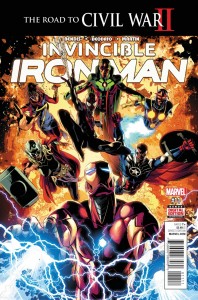 All of these Marvel books involve Civil War II connections. Spider-Woman has Jessica getting bugged by Carol to sign up for her Ulysses future-casting get-the-bad-guys-first campaign, pre-Rhodey-death; fortunately, that’s interspersed with a regular case involving going to Canada with the Porcupine and the baby to investigate Sasquatch outbreaks, and the book’s partly-serious, partly-slapstick approach to the case is as fun as always. Invincible Iron Man wraps up the long Tony-vs.-techno-ninjas-in-Japan arc, so its cover billing as “Road to Civil War II” is mostly misleading; it’s still a chance to see the regular pleasures of the Bendis/Deodato collaboration, plus a bunch of guest-stars, plus the teenage Riri, who’s created her own suit and
All of these Marvel books involve Civil War II connections. Spider-Woman has Jessica getting bugged by Carol to sign up for her Ulysses future-casting get-the-bad-guys-first campaign, pre-Rhodey-death; fortunately, that’s interspersed with a regular case involving going to Canada with the Porcupine and the baby to investigate Sasquatch outbreaks, and the book’s partly-serious, partly-slapstick approach to the case is as fun as always. Invincible Iron Man wraps up the long Tony-vs.-techno-ninjas-in-Japan arc, so its cover billing as “Road to Civil War II” is mostly misleading; it’s still a chance to see the regular pleasures of the Bendis/Deodato collaboration, plus a bunch of guest-stars, plus the teenage Riri, who’s created her own suit and 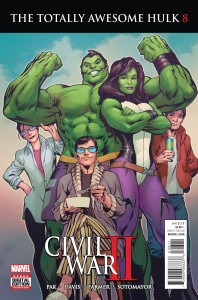 wants to be a hero, dressing up and going into action for the first time (since the news broke this week that, after CWII, she’s going to be the new Iron Man for awhile, everyone’s looking for her appearances in this title, so get this new issue while you can). Totally Awesome Hulk doesn’t seem to be about CWII; it’s actually about Bruce Banner coming to terms with the idea that he’s now completely, utterly cured of being the Hulk, and gives him some affecting moments as he experiences emotions like anger without getting all green and stupid; given the rumors about what’s going to happen in the next issue of Civil War II itself, it’s a chance for him to get some closure and some peace, at least for a week or two, and the
wants to be a hero, dressing up and going into action for the first time (since the news broke this week that, after CWII, she’s going to be the new Iron Man for awhile, everyone’s looking for her appearances in this title, so get this new issue while you can). Totally Awesome Hulk doesn’t seem to be about CWII; it’s actually about Bruce Banner coming to terms with the idea that he’s now completely, utterly cured of being the Hulk, and gives him some affecting moments as he experiences emotions like anger without getting all green and stupid; given the rumors about what’s going to happen in the next issue of Civil War II itself, it’s a chance for him to get some closure and some peace, at least for a week or two, and the 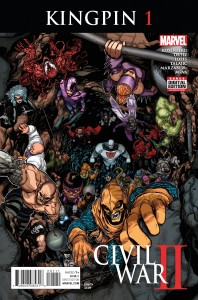 Pak/Davis team does a solid job of making a book with mostly conversation and people being friendly look interesting and inviting anyway. That leaves Kingpin, which you would think would be one of those unnecessary, cash-grab tie-ins; not so, thanks to the team of writer Rosenberg (whose 4 Kids Walk Into a Bank has established itself as a cool crime-noir/kid-group comic after just two issues) and artist Ortiz, whose collaborations with Ales Kot — Zero and Wolf — have honed his energetic, sketchy-but-hardboiled style, and made it perfect for a book like this, about what the crooks and mobsters get up to when all the big heroes are busy with the latest crossover.
Pak/Davis team does a solid job of making a book with mostly conversation and people being friendly look interesting and inviting anyway. That leaves Kingpin, which you would think would be one of those unnecessary, cash-grab tie-ins; not so, thanks to the team of writer Rosenberg (whose 4 Kids Walk Into a Bank has established itself as a cool crime-noir/kid-group comic after just two issues) and artist Ortiz, whose collaborations with Ales Kot — Zero and Wolf — have honed his energetic, sketchy-but-hardboiled style, and made it perfect for a book like this, about what the crooks and mobsters get up to when all the big heroes are busy with the latest crossover.
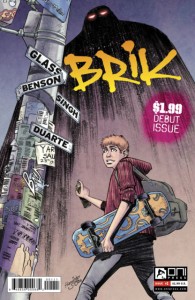 Brik #1 (of 6) — Writers: Adam Glass and Michael Benson; Art: Harwinder Singh; Colors: Gonzalo Duarte
Brik #1 (of 6) — Writers: Adam Glass and Michael Benson; Art: Harwinder Singh; Colors: Gonzalo Duarte
Throwaways #1 — Writer: Caitlin Kittredge; Art/Colors: Steven Sanders
Lone Ranger/Green Hornet #1 (of 6) — Writer: Michael Uslan; Art: Giovanni Timpano; Colors: Pete Pantazis
Cinema Purgatorio #3 — Creators: Various
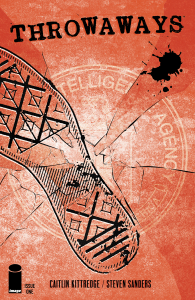 Paper Girls #7 — Writer: Brian K. Vaughan; Art: Cliff Chiang; Colors: Matt Wilson
Paper Girls #7 — Writer: Brian K. Vaughan; Art: Cliff Chiang; Colors: Matt Wilson
Assorted indy first issues, and others of note: Brik is an urban-gangster/oppressed residents version of the Golem myth, one of those comics by younger creators meant to show that they can tell a good story; they can, although it’s on a well-traveled road. Throwaways is young, edgy mutants on the run; it’s a little more self-assured, and the art has a rough-edged energy;  the reason to buy this book, though, is the four-page preview of Snotgirl, the new Bryan Lee O’Malley comic about an Internet fashion icon with a sinus problem, with high-gloss, manga-ish art by Leslie Hung and candy-coated colors by Mickey Quinn. Lone Ranger/Green Hornet is for people who already know how those two titular pulp icons are supposedly connected — a rapidly-shrinking demographic, but at least Uslan’s a good choice to keep it moving and hit all the right notes.
the reason to buy this book, though, is the four-page preview of Snotgirl, the new Bryan Lee O’Malley comic about an Internet fashion icon with a sinus problem, with high-gloss, manga-ish art by Leslie Hung and candy-coated colors by Mickey Quinn. Lone Ranger/Green Hornet is for people who already know how those two titular pulp icons are supposedly connected — a rapidly-shrinking demographic, but at least Uslan’s a good choice to keep it moving and hit all the right notes.  Cinema Purgatorio is an Alan Moore-curated anthology that leads with his and Kevin O’Neill’s title series, each episode about an off-kilter, creepy film shown in a B-movie theater in, well, purgatory; there’s also Garth Ennis and Raulo Caceres’s Code Pru, about a spunky EMT on the midnight shift who keeps encountering supernatural elements in her calls; Kieron Gillen and Ignacio Calero’s Modded, about a demonic invasion that’s devolved into a big game of Pokemon; the Max Brooks/Michael DiPascale
Cinema Purgatorio is an Alan Moore-curated anthology that leads with his and Kevin O’Neill’s title series, each episode about an off-kilter, creepy film shown in a B-movie theater in, well, purgatory; there’s also Garth Ennis and Raulo Caceres’s Code Pru, about a spunky EMT on the midnight shift who keeps encountering supernatural elements in her calls; Kieron Gillen and Ignacio Calero’s Modded, about a demonic invasion that’s devolved into a big game of Pokemon; the Max Brooks/Michael DiPascale  Civil War-era alternate-history alien-invasion giant-ants tale A More Perfect Union; and the Christos Gage/Gabriel Andrade super-sized giant-monster-with-Lovecraftian-influences The Vast. That’s an impressive array of talent for $5.99 — one dollar more than Civil War II, and about twice the pages, so there’s really no excuse for not giving it a try. Paper Girls, finally, has established itself as typically-addictive Brian K. Vaughan, with at least a couple of unexpected plot twists or over-the-top moments in every issue, a time-travel story that keeps getting stronger, and stranger, and Cliff Chiang art that’s crystal-clear, and makes all the characters compelling, likable and believable, despite the bizarre events they’re facing.
Civil War-era alternate-history alien-invasion giant-ants tale A More Perfect Union; and the Christos Gage/Gabriel Andrade super-sized giant-monster-with-Lovecraftian-influences The Vast. That’s an impressive array of talent for $5.99 — one dollar more than Civil War II, and about twice the pages, so there’s really no excuse for not giving it a try. Paper Girls, finally, has established itself as typically-addictive Brian K. Vaughan, with at least a couple of unexpected plot twists or over-the-top moments in every issue, a time-travel story that keeps getting stronger, and stranger, and Cliff Chiang art that’s crystal-clear, and makes all the characters compelling, likable and believable, despite the bizarre events they’re facing.



